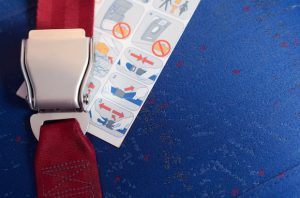If you fly on a commercial airliner and listen to the safety demo (most people don’t listen, of course), you may wonder why the video or crew instructs you how to use the seat belt.
(Originally, of course, airlines provided instructions because seat belts were only found in airplanes; they only arrived in cars in the 1960’s. The first airplane seat belts didn’t even click shut as they do today; you fastened them by squeezing the buckle onto the fabric belt.)
In the ensuing years, the need for seat belt lessons has been the butt of many a comedian’s joke (“In case you haven’t been in a car since 1965,” as Jerry Seinfeld quips in one of his stand up routines.
But that’s precisely the problem. You have been in a car lately; in fact, you probably unbuckled a car seat belt an hour before boarding your plane, and may have done so over and over in the days before your flight.
But car seat belts work differently from the “lift the buckle” way that airplane seat belts release. And believe it or not, in a panicked emergency, passengers who might not be thinking clearly because they’re disoriented or mentally incapacitated—barely awake before a 6 a.m. takeoff, jet-lagged after a long flight, or under the influence of Ambien or alcohol--have been known to reach to the right or left near their thighs, as you would in an automobile, trying to push a seat belt release button rather reaching for their laps and lifting a flap. In other words, previously established “muscle memory” works against you in a crisis.
How do I know this? Not only have flight attendants told me it happens, but I, someone who travels thousands of miles a year, have done the exact same thing at the end of a 12 hour flight with little sleep as I attempt to release the seat belt.
Because every second counts when evacuating a plane, any confusion could cost lives. In fact pilots are known to practice muscle memory in the cockpit, touching levers and fingering buttons before takeoff, so that in an emergency they will remember where the controls are located and be able to act quicker.
Something to think about the next time your nose is buried in a newspaper during the safety demo.
Want to become an air travel safety expert? British Airways offers flight safety training courses in London to groups and individuals. It’s fun and informative.






